Abstract
Background
The current study aims at using the whole genome expression profile chips for systematically investigating the diagnostic and prognostic values of excision repair cross-complementation (ERCC) genes in hepatitis B virus (HBV)-related hepatocellular carcinoma (HCC).
Materials and methods
Whole genome expression profile chips were obtained from the GSE14520. The receiver-operating characteristic (ROC) curve, survival analysis, and nomogram were used to investigate the diagnostic and prognostic values of ERCC genes. Investigation of the potential function of ERCC8 was carried out by gene set enrichment analysis (GSEA) and genome-wide coexpression analysis.
Results
ROC analysis suggests that six ERCC genes (ERCC1, ERCC2, ERCC3, ERCC4, ERCC5, and ERCC8) were dysregulated and may have potential to distinguish between HBV-related HCC tumor and paracancerous tissues (area under the curve of ROC ranged from 0.623 to 0.744). Survival analysis demonstrated that high ERCC8 expression was associated with a significantly decreased risk of recurrence (adjusted P=0.021; HR=0.643; 95% CI=0.442–0.937) and death (adjusted P=0.049; HR=0.631; 95% CI=0.399–0.998) in HBV-related HCC. Then, we also developed two nomograms for the HBV-related HCC individualized prognosis predictions. GSEA suggests that the high expression of ERCC8 may have involvement in the energy metabolism biological processes. As the genome-wide coexpression analysis and functional assessment of ERCC8 suggest, those coexpressed genes were significantly enriched in multiple biological processes of DNA damage and repair.
Conclusion
The present study indicates that six ERCC genes (ERCC1, ERCC2, ERCC3, ERCC4, ERCC5, and ERCC8) were dysregulated between HBV-related HCC tumor and paracancerous tissues and that the mRNA expression of ERCC8 may serve as a potential biomarker for the HBV-related HCC prognosis.
Introduction
Liver cancer is one of the most frequent malignant tumors occurring in China; besides, it has emerged as the third leading cause of cancer death in China.Citation1 According to cancer statistics in China in 2015, liver cancer is most frequently observed in males as well as in rural areas. Moreover, the temporal tendency of incidence rates in liver cancer is decreased.Citation1 The histological type of most primary liver cancers is hepatocellular carcinoma (HCC).Citation2 Hepatitis B virus (HBV) infection is identified as a risk factor for HCC, especially in China, where the infection rate of HBV is quite high. HBV is a single-stranded DNA virus, which can be integrated into the host genome, subsequently may activate the cellular proto-oncogenes or suppress growth-regulating genes in cis,Citation3 and induce chromosomal instability or insertional mutations.Citation4 HBV-induced DNA damage is one of the potential mechanisms that contribute to the hepatocarcinogenesis of HCC.Citation5
The excision repair cross-complementation (ERCC) genes include ERCC1, ERCC2, ERCC3, ERCC4, ERCC5, ERCC6, and ERCC8, constituting a set of proteins that are involved in DNA repair. Nucleotide excision repair (NER) is considered as an extensively pivotal excision mechanism, which removes DNA damage caused by various kinds factors, and a key DNA repair pathway in eukaryotic cells, whereas the ERCC genes constitute the key genes in the NER pathway.Citation6,Citation7 As revealed by the investigations, the genetic variation or mutation of the NER pathway genes is likely to impact the cancer risk by affecting the DNA repair efficacy, and some nonsynonymous coding single-nucleotide polymorphisms or mutations in DNA repair genes or their regulatory sequences induce the phenotypic changes and are involved in cancer development.Citation8 Previous reports of the ERCC genes, suggesting they were associated with multiple cancer prognoses,Citation9–Citation12 and polymorphisms of the ERCC genes also have significant association with the HCC development, progression, survival, and cancer susceptibility.Citation5,Citation13–Citation15 However, the systematic investigation of the diagnostic and prognostic values of the expression level of ERCC genes in HCC continue to be unclear. Therefore, the aim of the present study was to use the whole genome expression data set from the Gene Expression Omnibus (GEO; https://www.ncbi.nlm.nih.gov/geo/) public database for the purpose of systematically investigating the diagnostic and prognostic values of ERCC genes in HBV-related HCC.
Materials and methods
Data processing
In order to perform the present study, the inclusion criteria of public data set were set as follows: 1) the patients were HBV-related HCC; 2) the information of clinical outcome and features should be available; and 3) the data are the whole genome expression profile data. Through the retrieval of the public database, only the data set of GSE14520 caters to the inclusion criteria. GSE14520 (https://www.ncbi.nlm.nih.gov/geo/query/acc.cgi?acc=GSE14520; accessed May 13, 2018), a data set from the GEO public database, was included in the present study. Calculation of the expression profile chip data set of GSE14520 was carried out with the use of the match probes package in the R platform; subsequent to that, the robust multi-array average (RMA) method in the R affy package was used to obtain probe set expression summaries.Citation16,Citation17 Details of the experiment protocols and data processing are available at https://www.ncbi.nlm.nih.gov/geo/query/acc.cgi?acc=GSM362992. Moreover, just the data set of the Affymetrix HT Human Genome U133A Array (platform GPL3921) was included in the current study to avoid the batch effect. These patients having a clearly HBV infection were included in the current study, and those patients without complete prognostic information and other clinical features were excluded. Owing to the fact that the population included in the current study originates from the public databases and the present study does not contain any studies performed by any of the authors with human participants or animals, there is no need for approval by additional ethics committees.
Expression distribution and survival analysis of ERCC genes
Investigation of the expression distribution of ERCC genes was carried out with the help of the independent samples t-test and the Metabolic gEne RApid Visualizer (MERAV, http://merav.wi.mit.edu/, accessed May 13, 2018) online tool.Citation18 Receiver-operating characteristic (ROC) curves were put to use for the investigation of the potential application values in distinct HBV-related HCC tumors and adjacent normal liver tissues. The Kaplan–Meier method, with a log-rank test, and the univariate and multivariate Cox proportional hazards regression models were employed for the purpose of comparing the prognosis between different groups. Stratified analysis was employed for the assessment of the prognostic values of prognostic ERCC genes in different strata of HBV-related HCCs. Joint effect survival analyses between prognostic ERCC genes and serum alpha-fetoprotein (AFP), which is a recognized prognostic biomarker in HCC, have also been carried out for investigating the combined effect on HCC prognosis prediction. The high- and low-expression groups of the ERCC family genes were cutoff in accordance with the median values.Citation19–Citation22
Nomogram construction
To investigate the individualized prognostic prediction and evaluation system, we also developed a nomogram for the evaluation of the prognostic risk of each patient, which was based on the prognostic clinical indicators and prognostic-related ERCC genes of Cox regression model. Besides that, evaluation of the nomogram was using the concordance index (c-index). The nomogram was carried out by an rms package (https://CRAN.R-project.org/package=rms), together with its dependent packages in the R platform, with visualization using gplots.Citation23,Citation24
Gene set enrichment analysis (GSEA)
In a bid to figure out the potential mechanism of prognostic-related ERCC genes participating in the HBV-related HCC prognosis, we further performed a GSEA (http://software.broadinstitute.org/gsea/index.jsp) to discover the potential biological processes and pathways involved in the different expression levels of ERCC genes.Citation25,Citation26 The Molecular Signatures Database of GSEA used the c2 (c2. all.v6.1.symbols.gmt) and c5 (c5.all.v6.1.symbols.gmt) reference gene sets.Citation27 Results with a P-value below 0.05 and false discovery rate (FDR) below 0.25 were considered statistically significant.
Coexpression analysis
To further evaluate the function of ERCC8 in HBV-related HCC, we further carried out a genome-wide coexpression analysis of ERCC8 in the HBV-related HCC of the GSE14520 cohort. The Pearson’s correlation coefficient was used to evaluate the coexpression genes, and the Database for Annotation, Visualization and Integrated Discovery (DAVID; https://david.ncifcrf.gov/home.jsp, accessed May 13, 2018) v6.8Citation28,Citation29 was used for the purpose of functional assessment.
Statistical analysis
FDR in the GSEA was used to estimate the probability that the normalized enrichment score represents a false-positive finding, which was calculated with the help of the Benjamini and Hochberg method. A P-value <0.05 was regarded as statistically significant. All the statistical analyses were performed using SPSS v20.0 (IBM Corporation, Armonk, NY, USA) and R3.3.1 (https://www.r-project.org/).
Results
Study population
A total of 212 HBV-related HCC patients were included in the present study, coupled with 204 adjacent normal liver tissue specimens. Both the demographic and clinical features have been presented in . The clinical features including gender, cirrhosis, Barcelona Clinic Liver Cancer (BCLC) stage, TNM stage, and Cancer of the Liver Italian Program (CLIP) stage were significantly associated with the recurrence-free survival (RFS) of the HBV-related HCC, whereas the clinical features including cirrhosis, tumor size, BCLC stage, TNM stage, CLIP stage, and serum AFP were significantly correlated with overall survival (OS).
Table 1 Distribution of HCC patients’ characteristics and prognosis analysis
Expression distribution and survival analysis of ERCC genes
Through the comparison of the expression of ERCC genes in the HBV-related HCC tumor tissues and adjacent normal liver tissues, we observed that ERCC1, ERCC2, ERCC3, and ERCC8 were significantly upregulated in the HBV-related HCC tumor tissues, whereas ERCC4 and ERCC5 were significantly downregulated in the HBV-related HCC tumor tissues (). These dysregulated genes are also observable in liver cancer using the MERAV online tool (). Thereafter, we performed the investigation of the potential application values of the ERCC genes in distinguishing the HBV-related HCC tumor tissues and adjacent normal liver tissues using the ROC curve. As the ROC analysis suggests, six ERCC genes (ERCC1, ERCC2, ERCC3, ERCC4, ERCC5, and ERCC8) could be a biomarker used to distinguish between HBV-related HCC tumor tissues and the adjacent normal liver tissues; the area under the curve of the ROC was in the range between 0.623 and 0.744 ().
Figure 1 Gene expression distribution of ERCC genes in GSE14520 HBV-related HCC cohort.
Notes: ***P<0.001; ****P<0.0001.
Abbreviations: ERCC, excision repair cross-complementation; HBV, hepatitis B virus; HCC, hepatocellular carcinoma.
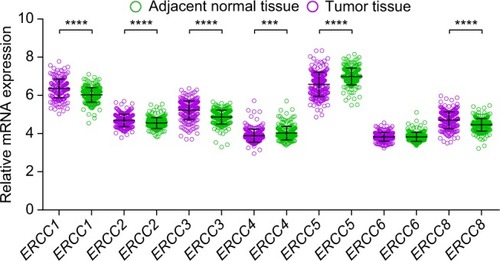
Figure 2 Gene expression distribution of ERCC gene in liver cancer using the MERAV.
Note: The order of box plots of ERCC genes were as follows: ERCC1 (A), ERCC2 (B), ERCC3 (C), ERCC4 (D), ERCC5 (E), ERCC6 (F), and ERCC8 (G).
Abbreviations: ERCC, excision repair cross-complementation; MERAV, Metabolic gEne RApid Visualizer.
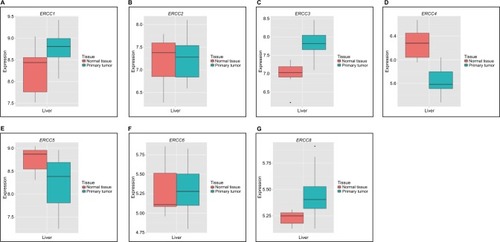
Figure 3 ROC curves of ERCC genes in distinguish HBV-related HCC tissue from adjacent normal liver tissue.
Note: The order of ROC curves of ERCC genes were as follows: ERCC1 (A), ERCC2 (B), ERCC3 (C), ERCC4 (D), ERCC5 (E), ERCC6 (F), and ERCC8 (G).
Abbreviations: AUC, area under the curve of ROC; ERCC, excision repair cross-complementation; HBV, hepatitis B virus; HCC, hepatocellular carcinoma; ROC, receiver-operating characteristic.
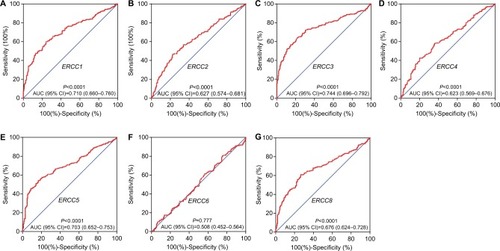
Survival analysis of ERCC family genes has been presented in and ; these findings provide the demonstration that the high ERCC8 expression significantly reduced the risk of recurrence (adjusted P=0.021; HR=0.643; 95% CI=0.442–0.937, , ) and death (adjusted P=0.049; HR=0.631; 95% CI=0.399–0.998, , ) in the HBV-related HCC. Stratification analysis was also used to assess the prognostic values of ERCC8 in the HBV-related HCC. The high expression of ERCC8 significantly reduced the risk of recurrence in the patients having cirrhosis, serum AFP >300 ng/mL, single nodules, and in the male patients (), whereas the high expression of ERCC8 significantly reduced the risk of death in the patients having single nodules, together with the male patients (). The joint effect survival analysis of ERCC8 and serum AFP suggests that the patients with high ERCC8 expression and a serum AFP ≤300 ng/mL (adjusted P=0.035; HR=0.583; 95% CI=0.354–0.962, , ) or >300 ng/mL (adjusted P=0.004; HR=0.426; 95% CI=0.237–0.768, , ) showed a significantly decreased risk of recurrence in the HBV-related HCC compared with patients having AFP >300 ng/mL and low ERCC8 expression. In contrast, the patients with high ERCC8 expression and AFP ≤300 ng/mL showed a significantly reduced risk of death in the HBV-related HCC (adjusted P=0.028; HR=0.499; 95% CI=0.268–0.927, , ) compared with patients having AFP >300 ng/mL and low ERCC8 expression.
Table 2 Survival analysis of ERCC genes in HBV-related HCC prognosis
Table 3 Stratified survival analysis of ERCC8 in HBV-related HCC prognosis
Table 4 Joint effect survival analysis of ERCC8 and serum AFP in HBV-related HCC prognosis
Figure 4 Kaplan–Meier curves of ERCC genes in HBV-related HCC RFS.
Note: The order of Kaplan–Meier curves of ERCC genes were as follows: ERCC1 (A), ERCC2 (B), ERCC3 (C), ERCC4 (D), ERCC5 (E), ERCC6 (F), and ERCC8 (G).
Abbreviations: ERCC, excision repair cross-complementation; HBV, hepatitis B virus; HCC, hepatocellular carcinoma; RFS, recurrence-free survival.
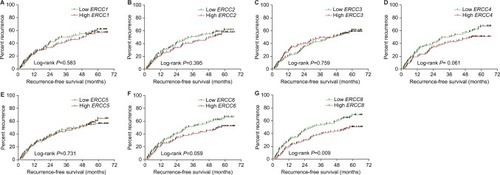
Figure 5 Kaplan–Meier curves of ERCC genes in HBV-related HCC OS.
Note: The order of Kaplan–Meier curves of ERCC genes were as follows: ERCC1 (A), ERCC2 (B), ERCC3 (C), ERCC4 (D), ERCC5 (E), ERCC6 (F), and ERCC8 (G).
Abbreviations: ERCC, excision repair cross-complementation; HBV, hepatitis B virus; HCC, hepatocellular carcinoma; OS, overall survival.
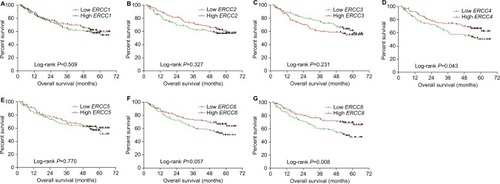
Figure 6 Joint effect survival analysis of ERCC8 and AFP in HBV-related HCC prognosis.
Notes: (A) RFS stratified by ERCC8 and serum AFP level; (B) OS stratified by ERCC8 and serum AFP level; (C) RFS stratified by ERCC8 and AFP mRNA level; and (D) OS stratified by ERCC8 and serum AFP mRNA level.
Abbreviations: AFP, alpha-fetoprotein; ERCC, excision repair cross-complementation; HBV, hepatitis B virus; HCC, hepatocellular carcinoma; OS, overall survival; RFS, recurrence-free survival.
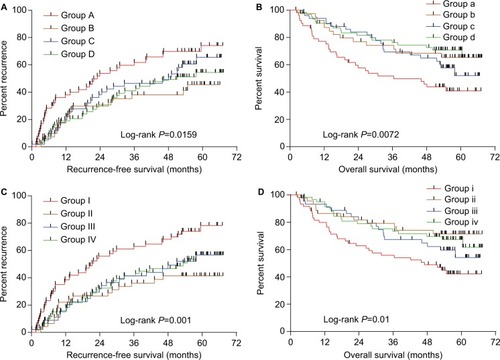
Thereafter, we also performed the verification of these joint effect survival analyses between ERCC8 and AFP mRNA expression level and demonstrated that the AFP mRNA expression also performed well in the HCC prognosis prediction. Patients with high ERCC8 expression and low (adjusted P=0.003; HR=0.443; 95% CI=0.259–0.757, , ) or high (adjusted P=0.002; HR=0.418; 95% CI=0.238–0.734, , ) AFP level showed a significantly decreased risk of recurrence in the HBV-related HCC compared with patients who had high AFP and low ERCC8 expression, as well as in patients with low AFP and ERCC8 expression (adjusted P=0.004; HR=0.425; 95% CI=0.238–0.757, , ). With respect to OS, we observed that the patients with high ERCC8 expression and low AFP expression showed a significantly reduced risk of death in the HBV-related HCC (adjusted P=0.035; HR=0.487; 95% CI=0.249–0.952, , ) compared with patients who had high AFP and low ERCC8 expression.
Nomogram construction
Thereafter, we performed the investigation of the potential application of ERCC8 mRNA expression in the individual-ized prognosis prediction. Those clinical features that were significantly correlated to RFS or OS were included in the development of nomogram for RFS and OS, correspondingly. The nomogram of the HBV-related HCC RFS was developed in accordance with the gender, cirrhosis, TMN stage, BCLC stage, CLIP stage, and ERCC8 expression (c-index [95% CI]=0.68 [0.63–0.74], ), whereas the nomogram of HBV-related HCC OS was developed by tumor size, cirrhosis, TMN stage, BCLC stage, CLIP stage, AFP, and ERCC8 expression (c-index [95% CI]=0.72 [0.66–0.79], ). In accordance with the nomogram for RFS and OS, we observed that the contribution of ERCC8 expression in the HBV-related HCC prognosis prediction was lower compared with some conventional clinical indicators; however, the expression of ERCC8 contributed much more than the serum AFP in the nomogram of the HBV-related HCC OS ().
Figure 7 Nomogram for predicting the 1-, 3-, and 5-year event with ERCC8 expression and clinical indicators.
Notes: (A) Nomogram for ERCC8 expression in HBV-related HCC RFS. (B) Nomogram for ERCC8 expression in HBV-related HCC OS.
Abbreviations: AFP, alpha-fetoprotein; BCLC, Barcelona Clinic Liver Cancer; CLIP, Cancer of the Liver Italian Program; ERCC, excision repair cross-complementation; HBV, hepatitis B virus; HCC, hepatocellular carcinoma; OS, overall survival; RFS, recurrence-free survival.
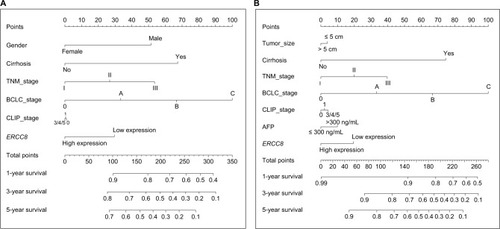
GSEA of ERCC8
Investigation by GSEA using the c2 reference gene set indicates that the high expression of ERCC8 was significantly enriched in the NF-kappa-B and Wnt signaling pathway, as well as the P53 independent G1-S DNA damage checkpoint, TCA cycle and respiratory electron transport, and oxidative phosphorylation (, Table S1). GSEA with c5 indicates that the high expression of ERCC8 was significantly correlated to metabolically related biological processes, for instance, nucleoside triphosphate and cellular amine metabolic processes, and the generation of precursor metabolites and energy (, Table S2). In comparison, using the results of the c2 and c5 reference gene set, we observed that the high expression of ERCC8 may be involved in energy metabolism biological processes, which may have an impact on the prognosis of the HBV-related HCC.
Figure 8 GSEA results of ERCC8.
Notes: (A)–(F) GSEA results of c2 reference gene sets for high ERCC8 expression. (G)–(I) GSEA results of c5 reference gene sets for high ERCC8 expression.
Abbreviations: ERCC, excision repair cross-complementation; GSEA, gene set enrichment analysis; FDR, false discovery rate; ES, Enrichment Score; NES, Normalized Enrichment Score.
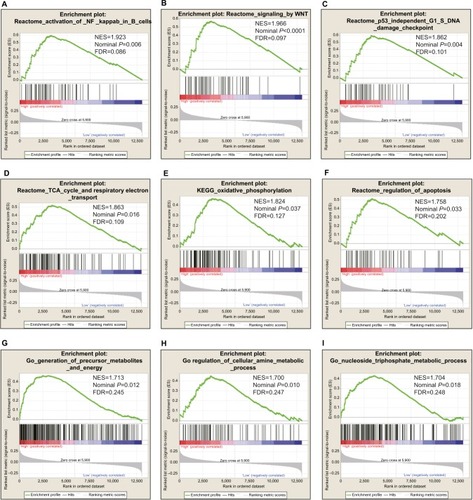
Genome-wide coexpression analysis and function assessment of ERCC8
For the purpose of further exploring the function of ERCC8 in the HBV-related HCC, a genome-wide coexpression analysis was carried out. With respect to the multiple probes corresponding to one gene, we used the mean values of multiple probes to present the expression values of this gene in a genome-wide coexpression analysis. A total of 273 genes with |Pearson’s correlation coefficient|>0.4 and P<0.05 were taken into consideration as coexpressed with ERCC8 in the HBV-related HCC (, Table S3). Thereafter, the functional assessment of the ERCC8-coexpressed genes was performed using DAVID v6.8. Gene Ontology (GO) term analysis suggested that ERCC8 and its coexpressed genes together are significantly enriched in the MAPK cascade, damaged DNA binding, DNA synthesis involved in DNA repair, and DNA damage checkpoints (). In contrast, the Kyoto Encyclopedia of Genes and Genomes suggested that ERCC8 and its coexpressed genes were significantly enriched in the ribosome-signaling pathway (hsa03010, P=0.003, gene count=8).
Figure 9 Coexpression genes of ERCC8 in HBV-related HCC.
Figure 10 GO term enrichments of coexpression genes of ERCC8 in HBV-related HCC.
Abbreviations: ERCC, excision repair cross-complementation; GO, Gene Ontology; HBV, hepatitis B virus; HCC, hepatocellular carcinoma.

Notes: The green nodes represent negative correlation with ERCC8, and the red nodes represent positive correlation with ERCC8.
Abbreviations: ERCC, excision repair cross-complementation; HBV, hepatitis B virus; HCC, hepatocellular carcinoma.

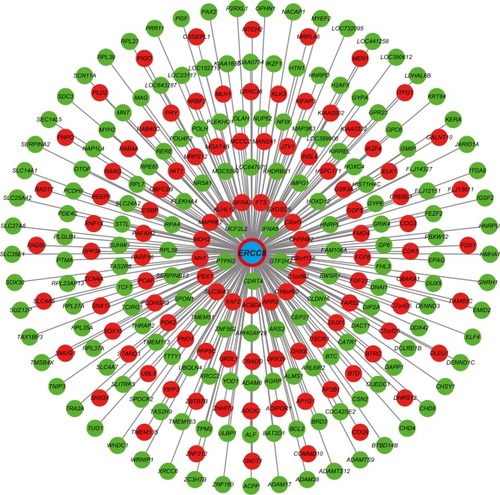
Discussion
Through the review of the literature, we observed that extensive previous studies have focused on the investigation of the association between the ERCC gene polymorphisms and the risk of cancersCitation30,Citation31 or on the ERCC gene polymorphisms and cancer prognosis.Citation32,Citation33 Besides that, the ERCC gene polymorphisms have also been reported for having correlation with the prognosis of patients treated with chemotherapy.Citation34–Citation37 However, there are rare reports of the systematic investigations of the expression of ERCC in cancer diagnosis and prognosis.Citation9,Citation38,Citation39
Previous studies substantiated that polymorphisms in ERCC2 and ERCC5 confer susceptibility to the acute myeloid leukemia (AML)Citation40 and that polymorphisms in ERCC2 and XPC were significantly associated with the AML survival.Citation41 Polymorphisms in ERCC5 also make contribution toward the susceptibility of lung cancer and squamous cell carcinomas of the oropharynx, larynx, and esophagus;Citation42 head and neck;Citation43 prostate cancer;Citation44 HCC;Citation15 and bladder cancer (BC).Citation31 A study performed by Sakano et al also found that the genetic variants of ERCC5 contribute to the tumor invasiveness in BC.Citation45 In addition, the polymorphisms ERCC2-rs1799793 and ERCC5-rs17655 may also contribute to the recurrence risk of squamous cell carcinoma of the oropharynx.Citation37
There have also been reports of the prognostic values of ERCC genetic variants in multiple cancers. An investigation carried out by Liu et al revealed the fact that ERCC1-rs11615 is likely to be a useful genetic marker for the prediction of the osteosarcoma prognosis and that the CC genotype is correlated with a better clinical outcome.Citation46 The work performed by Liu et al indicated that the XRCC1-399A/A genotype was significantly correlated with a better clinical outcome.Citation47 Previous studies demonstrated that genetic variants of ERCC2 and ERCC5 may be the independent prognostic factors in the patients with melanomaCitation32,Citation48 and osteosarcoma.Citation49 In addition, polymorphisms of ERCC5 were also correlated with the response to chemotherapy and the prognosis of osteosarcoma.Citation50,Citation51 Furthermore, polymorphisms of ERCC5 have also been reported to have an influence in multiple cancer prognosis, such as lung cancer,Citation33,Citation47 and colorectal cancer (CRC).Citation52,Citation53
The interindividual differences in the patients treated with chemotherapy mainly affected the efficiency of the DNA damage–repair system in the cells and then affected the clinical outcomes. Extensive studies have demonstrated that the ERCC genes were involved in the responses to chemotherapy and the prognosis of the patients with CRCCitation36,Citation54–Citation56 as well as advanced non-small cell lung cancer (NSCLC).Citation57,Citation58 The ERCC5 polymorphism His46His was reported to be associated with the susceptibility of platinum-based chemotherapy in the advanced NSCLCCitation35 and significantly affected clinical outcomes.Citation58 The ERCC5 promoter polymorphism rs751402 was significantly associated with the chemotherapy response in the advanced NSCLC, and the AA genotype may contribute to increase the effect of chemotherapy response.Citation59 Hu et al substantiated that the rs2296147 T allele and rs873601 G allele were associated with the better progression-free survival (PFS) and OS in the advanced NSCLC patients undergoing the platinum-based chemotherapyCitation57; furthermore, the results of the rs2296147 T allele in OS of the advanced NSCLC patients undergoing platinum-based chemotherapy are also verifiable in another cohort.Citation60 However, the rs1047768 TT genotype, which showed a significantly shortened median PFS and OS in the advanced NSCLC patients undergoing platinum-based chemotherapy in the study of Zhang et al,Citation60 is unable to be verified in the cohort collected by Hu et al.Citation57 With respect to the ERCC genetic variation in CRC response to platinum-based chemotherapy and therapeutic outcomes, multiple studies demonstrated that the ERCC5 polymorphisms may have an impact on the susceptibility and therapeutic outcomes to the colorectal cancer patients, who received oxaliplatin chemotherapy.Citation36,Citation54–Citation56
By reviewing the above literature, we found that a considerable amount of literature has been published on the genetic variation of ERCC genes in cancer susceptibility, prognosis, and therapeutic outcomes; however, the expression of ERCC genes in cancer diagnostic and prognostic values were rarely mentioned. Several investigations verified the fact that the low expression of ERCC1 was significantly correlated with a better clinical outcome in patients with breast cancer,Citation38 NSCLC,Citation61 and ovarian cancer,Citation9 as well as in advanced NSCLC treated with platinum-based chemotherapy.Citation10 A systematic investigation of the ERCC genes in the ovarian cancer prognosis was carried out by Zhao et al using the Kaplan–Meier Plotter online tool and revealed that the high expression of ERCC8 and ERCC1 had correlations with a poor OS, whereas the high expression of ERCC4 was associated with a better OS.Citation9 In our current study, we observed that the high expression of ERCC8 was significantly correlated with a better RFS and OS in the HBV-related HCC after hepatectomy, and our current study was the first to investigate the potential prognostic application values of ERCC8 in the HBV-related HCC. Comprehensive survival analysis of stratification analysis and joint effect survival analysis indicates that ERCC8 may be served as an independent prognostic indicator for the HBV-related HCC; the nomograms indicate that the combination of ERCC8 and traditional prognostic indicators may have an application value in the individualized prognosis prediction. It is worth noting that the results of ERCC8 obtained in our current study were contradictory to the results of the study carried out by Zhao et al in the ovarian cancer prognosis.Citation9 The possible causes of the above inconsistency results suggested that the survival analysis in the study by Zhao et al was derived from the Kaplan–Meier method, which was a univariate survival analysis and that the results obtained from such kinds of statistical methods may be unreliable. However, the key advantage of the results of the current study was assessed by a multivariate Cox proportional hazards regression model, and the statistical method was more reliable than the Kaplan–Meier method in survival analysis. Another possible reason may be that ERCC8 plays different roles in both the ovarian cancer and HBV-related HCC. However, these results still require to be further verified in a larger sample, and the hypotheses also need further experimental validation.
The current study has some limitations that need to clarification. First, since the data set is from the public database, the clinical information in the GSE14520 was constrained. Consequently, we are incapable of attaining complete clinical information with which to carry out a comprehensive prognostic analysis; the incomplete clinical information, such as postoperative treatment, may influence prognosis. Second, the raw values of serum AFP level in GSE14520 were not provided as well, accordingly, we were unable to carry out a joint effect survival analysis in the serum with an AFP cutoff 400 ng/mL, which is a recognized cutoff value. Third, through the retrieval of the public database, only the GSE14520 data set caters to the requirements of the current study. That is why the results of the present study are derived from a single cohort, and additional cohorts to verify the results are needed.
Despite these limitations, our current study is the first to systematically investigate the diagnostic and prognostic values of ERCC genes in the HBV-related HCC. As our findings suggest, the dysregulated ERCC genes may have a potential application in the HBV-related HCC diagnosis and ERCC8 may be a potential novel indicator for the HBV-related HCC prognosis prediction. We also developed two nomograms for the individualized prognosis prediction and investigated the potential mechanisms and functions of ERCC8 in the HBV-related HCC using the GSEA and genome-wide coexpression analysis approaches.
Conclusion
The present study indicates that six ERCC genes (ERCC1, ERCC2, ERCC3, ERCC4, ERCC5, and ERCC8) were dysregulated between the HBV-related HCC tumor and paracancerous tissues, and mRNA expression of ERCC8 may act as a potential biomarker for the HBV-related HCC prognosis.
Acknowledgments
This work was supported in part by the National Natural Science Foundation of China (Grant NO.81460512) and Shandong Province Education Department Colleges and Universities Science and Technology Plan Project (J17KB088). The authors thank the contributors of the GSE14520 for sharing the HBV-related HCC expression profile data set on open access. In addition, we would like to acknowledge the helpful comments on this article received from our reviewers.
Disclosure
The authors report no conflicts of interest in this work.
References
- ChenWZhengRBaadePDCancer statistics in China, 2015CA Cancer J Clin201666211513226808342
- TangDNaganoHNakamuraMClinical and pathological features of Allen’s type C classification of resected combined hepatocellular and cholangiocarcinoma: a comparative study with hepatocellular carcinoma and cholangiocellular carcinomaJ Gastrointest Surg200610798799816843869
- MckillopIHMoranDMJinXKoniarisLGMolecular pathogenesis of hepatocellular carcinomaJ Surg Res2006136112513517023002
- PangRTseEPoonRTMolecular pathways in hepatocellular carcinomaCancer Lett2006240215716916239065
- JungSWParkNHShinJWPolymorphisms of DNA repair genes in Korean hepatocellular carcinoma patients with chronic hepatitis B: possible implications on survivalJ Hepatol201257362162722659345
- Le MayNEglyJ-MCoinFTrue lies: the double life of the nucleotide excision repair factors in transcription and DNA repairJ Nucleic Acids20102010110
- HouSMFältSAngeliniSThe XPD variant alleles are associated with increased aromatic DNA adduct level and lung cancer riskCarcinogenesis200223459960311960912
- KarahalilBBohrVAWilsonDMImpact of DNA polymorphisms in key DNA base excision repair proteins on cancer riskHum Exp Toxicol20123110981100523023028
- ZhaoMLiSZhouLShenQZhuHZhuXPrognostic values of excision repair cross-complementing genes mRNA expression in ovarian cancer patientsLife Sci2018194343929247747
- QinXYaoWLiWERCC1 and BRCA1 mRNA expressions are associated with clinical outcome of non-small cell lung cancer treated with platinum-based chemotherapyTumour Biol20143554697470424443257
- SunJMAhnMJParkMJExpression of excision repair cross-complementation group 1 as predictive marker for nasopharyngeal cancer treated with concurrent chemoradiotherapyInt J Rad Oncol Biol Phys2011803655660
- GrimmingerPPShiMBarrettCTS and ERCC-1 mRNA expressions and clinical outcome in patients with metastatic colon cancer in CONFIRM-1 and -2 clinical trialsPharmacogenomics J201212540441121788964
- LiLMZengXYJiL[Association of XPC and XPG polymorphisms with the risk of hepatocellular carcinoma] XPC hé XPG duō tài xìng yǔ gān xìbāo ái fēngxiǎn de guānxìZhonghua Gan Zang Bing Za Zhi2010184271275 Chinese20460046
- SakuradaTYoshikawaMSunagaMExpression of drug-resistant factor genes in hepatocellular carcinoma patients undergoing chemotherapy with platinum complex by arterial infusionPharmaceutics20102330031227721358
- YoonAJKuoWHLinCWYangSFRole of ERCC5 polymorphism in risk of hepatocellular carcinomaOncol Lett20112591191422866149
- RoesslerSLongELBudhuAIntegrative genomic identification of genes on 8p associated with hepatocellular carcinoma progression and patient survivalGastroenterology2012142495796622202459
- RoesslerSJiaHLBudhuAA unique metastasis gene signature enables prediction of tumor relapse in early-stage hepatocellular carcinoma patientsCancer Res20107024102021021221159642
- ShaulYDYuanBThiruPMERAV: a tool for comparing gene expression across human tissues and cell typesNucleic Acids Res201644D1D560D56626626150
- LiaoXHuangKHuangRGenome-scale analysis to identify prognostic markers in patients with early-stage pancreatic ductal adenocarcinoma after pancreaticoduodenectomyOnco Targets Ther2017104493450628979141
- LiaoXHuangRLiuXDistinct prognostic values of alcohol dehydrogenase mRNA expression in pancreatic adenocarcinomaOnco Targets Ther2017103719373228769575
- LiaoXLiuXYangCDistinct diagnostic and prognostic values of minichromosome maintenance gene expression in patients with hepatocellular carcinomaJ Cancer20189132357237330026832
- HuangRLiaoXLiQIdentification and validation of potential prognostic gene biomarkers for predicting survival in patients with acute myeloid leukemiaOnco Targets Ther2017105243525429138577
- LiaoXZhuGHuangRIdentification of potential prognostic microRNA biomarkers for predicting survival in patients with hepatocellular carcinomaCancer Manag Res20181078780329713196
- LiaoXYangCHuangRIdentification of potential prognostic long non-coding RNA biomarkers for predicting survival in patients with hepatocellular carcinomaCell Physiol Biochem20184851854186930092592
- SubramanianATamayoPMoothaVKGene set enrichment analysis: a knowledge-based approach for interpreting genome-wide expression profilesProc Natl Acad Sci200510243155451555016199517
- MoothaVKLindgrenCMErikssonKFPGC-1alpha-responsive genes involved in oxidative phosphorylation are coordinately downregulated in human diabetesNat Genet200334326727312808457
- LiberzonABirgerCThorvaldsdóttirHGhandiMMesirovJPTamayoPThe Molecular Signatures Database (MSigDB) hallmark gene set collectionCell Syst20151641742526771021
- DennisGShermanBTHosackDADAVID: Database for Annotation, Visualization, and Integrated DiscoveryGenome Biol200345P312734009
- HuangDawShermanBTLempickiRASystematic and integrative analysis of large gene lists using DAVID bioinformatics resourcesNat Protoc200941445719131956
- QiuLWangZShiXWangZAssociations between XPC polymorphisms and risk of cancers: a meta-analysisEur J Cancer200844152241225318771913
- García-ClosasMMalatsNRealFXGenetic variation in the nucleotide excision repair pathway and bladder cancer riskCancer Epidemiol Biomarkers Prev200615353654216537713
- LiCYinMWangLEPolymorphisms of nucleotide excision repair genes predict melanoma survivalJ Invest Dermatol201313371813182123407396
- MatakidouAEl GaltaRWebbELGenetic variation in the DNA repair genes is predictive of outcome in lung cancerHum Mol Genet200716192333234017855454
- SchöffskiPTaronMJimenoJPredictive impact of DNA repair functionality on clinical outcome of advanced sarcoma patients treated with trabectedin: a retrospective multicentric studyEur J Cancer20114771006101221376569
- SunXLiFSunNPolymorphisms in XRCC1 and XPG and response to platinum-based chemotherapy in advanced non-small cell lung cancer patientsLung Cancer200965223023619157633
- KweekelDMAntoniniNFNortierJWPuntCJGelderblomHGuchelaarHJExplorative study to identify novel candidate genes related to oxaliplatin efficacy and toxicity using a DNA repair arrayBr J Cancer2009101235736219536092
- SongXSturgisEMJinLWangZWeiQLiGVariants in nucleotide excision repair core genes and susceptibility to recurrence of squamous cell carcinoma of the oropharynxInt J Cancer2013133369570423335232
- GoyalSParikhRRGreenCClinicopathologic significance of excision repair cross-complementation 1 expression in patients treated with breast-conserving surgery and radiation therapyInt J Rad Oncol, Biol, Phys2010763679684
- SasakiSWatanabeTNakayamaHAnalysis of the mRNA expression of chemotherapy-related genes in colorectal carcinoma using the Danenberg tumor profile methodJ Oncol20132013386906386906723577026
- BănescuCIancuMTrifaAPInfluence of XPC, XPD, XPF, and XPG gene polymorphisms on the risk and the outcome of acute myeloid leukemia in a Romanian populationTumour Biol20163779357936626779634
- StromSSEsteyEOutschoornUMGarcia-ManeroGAcute myeloid leukemia outcome: role of nucleotide excision repair polymorphisms in intermediate risk patientsLeuk Lymphoma201051459860520141440
- CuiYMorgensternHGreenlandSPolymorphism of Xeroderma Pigmentosum group G and the risk of lung cancer and squamous cell carcinomas of the oropharynx, larynx and esophagusInt J Cancer2006118371472016094634
- MaHYuHLiuZWangLESturgisEMWeiQPolymorphisms of XPG/ERCC5 and risk of squamous cell carcinoma of the head and neckPharmacogenet Genomics2012221505722108238
- ZhangXJLiuPZhuFPolymorphisms of DNA repair-related genes with susceptibility and prognosis of prostate cancerGenet Mol Res20141324419442424615090
- SakanoSKumarRLarssonPA single-nucleotide polymorphism in the XPG gene, and tumour stage, grade, and clinical course in patients with nonmuscle-invasive neoplasms of the urinary bladderBJU Int200697484785116536785
- LiuXZhangZDengCTianYMaXMeta-analysis showing that ERCC1 polymorphism is predictive of osteosarcoma prognosisOncotarget2017837627696277928977987
- LiuDWuJShiGYZhouHFYuYRole of XRCC1 and ERCC5 polymorphisms on clinical outcomes in advanced non-small cell lung cancerGenet Mol Res20141323100310724782167
- SchramaDSchererDSchneiderMERCC5 p.Asp1104His and ERCC2 p.Lys751Gln polymorphisms are independent prognostic factors for the clinical course of melanomaJ Invest Dermatol201113161280129021390047
- LiJLiuSWangWERCC polymorphisms and prognosis of patients with osteosarcomaTumour Biol20143510101291013625023406
- BaiSBChenHXBaoYXLuoXZhongJJPredictive impact of common variations in DNA repair genes on clinical outcome of osteosarcomaAsian Pac J Cancer Prev20131463677368023886164
- SunXHHouWGZhaoHXZhaoYLMaCLiuYSingle nucleotide polymorphisms in the NER pathway and clinical outcome of patients with bone malignant tumorsAsian Pac J Cancer Prev20131432049205223679317
- NegandhiAAHydeADicksEMTHFR Glu429Ala and ERCC5 His46His polymorphisms are associated with prognosis in colorectal cancer patients: analysis of two independent cohorts from NewfoundlandPLoS One201384e6146923626689
- WangFZhangSDXuHMXPG rs2296147 T>C polymorphism predicted clinical outcome in colorectal cancerOncotarget2016710117241173226887052
- LiuDWuHZZhangYNDNA repair genes XPC, XPG polymorphisms: relation to the risk of colorectal carcinoma and therapeutic outcome with oxaliplatin-based adjuvant chemotherapyMol Carcinog201251Suppl 1E83E9322213216
- ChenJLuoXXieGFunctional analysis of SNPs in the ERCC5 promoter in advanced colorectal cancer patients treated with oxaliplatin-based chemotherapyMedicine20169519e365227175691
- SunKGongALiangPPredictive impact of genetic polymorphisms in DNA repair genes on susceptibility and therapeutic outcomes to colorectal cancer patientsTumour Biol20153631549155925355595
- HuWPanJZhaoPYangGYangSGenetic polymorphisms in XPG could predict clinical outcome of platinum-based chemotherapy for advanced non-small cell lung cancerTumour Biol20143565561556724615519
- JinZYZhaoXTZhangLNWangYYueWTXuSFEffects of polymorphisms in the XRCC1, XRCC3, and XPG genes on clinical outcomes of platinum-based chemotherapy for treatment of non-small cell lung cancerGenet Mol Res20141337617762524737519
- HeCDuanZLiPXuQYuanYRole of ERCC5 promoter polymorphisms in response to platinum-based chemotherapy in patients with advanced non-small-cell lung cancerAnticancer Drugs201324330030523211354
- ZhangTSunJLvMXPG is predictive gene of clinical outcome in advanced non-small-cell lung cancer with platinum drug therapyAsian Pac J Cancer Prev201314270170523621222
- JeongYHLeeCKJoKCorrelation analysis and prognostic impact of (18)F-FDG PET and excision repair cross-complementation group 1 (ERCC-1) expression in non-small cell lung cancerNucl Med Mol Imaging201549210811426085855
